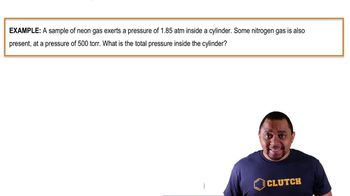(a) Two pans of water are on different burners of a stove. One pan of water is boiling vigorously, while the other is boiling gently. What can be said about the temperature of the water in the two pans?
Appendix B lists the vapor pressure of water at various external pressures. (a) Plot the data in Appendix B, vapor pressure (torr) versus temperature (°C). From your plot, estimate the vapor pressure of water at body temperature, 37 °C. (b) Explain the significance of the data point at 760.0 torr, 100 °C. (c) A city at an altitude of 500 ft below sea level would have a barometric pressure of 774 torr. To what temperature would you have to heat water to boil it in this city?
 Verified step by step guidance
Verified step by step guidanceKey Concepts
Vapor Pressure

Boiling Point

Altitude and Atmospheric Pressure

You are high up in the mountains and boil water to make some tea. However, when you drink your tea, it is not as hot as it should be. You try again and again, but the water is just not hot enough to make a hot cup of tea. Which is the best explanation for this result? (a) High in the mountains, it is probably very dry, and so the water is rapidly evaporating from your cup and cooling it. (b) High in the mountains, it is probably very windy, and so the water is rapidly evaporating from your cup and cooling it. (c) High in the mountains, the air pressure is significantly less than 1 atm, so the boiling point of water is much lower than at sea level. (d) High in the mountains, the air pressure is significantly less than 1 atm, so the boiling point of water is much higher than at sea level.
Using the vapor-pressure curves in Figure 11.25, (d) estimate the external pressure at which diethyl ether will boil at 40 °C.
Appendix B lists the vapor pressure of water at various external pressures. (c) A city at an altitude of 5000 ft above sea level has a barometric pressure of 633 torr. To what temperature would you have to heat water to boil it in this city?
